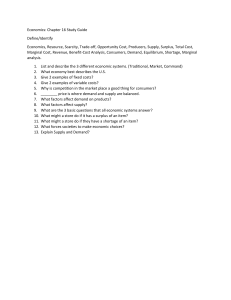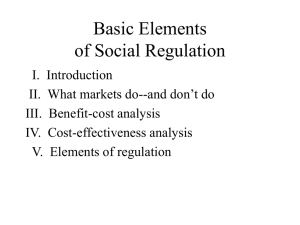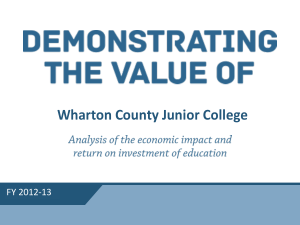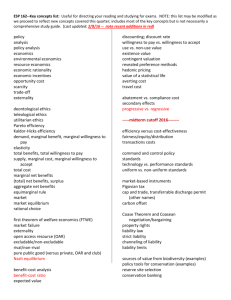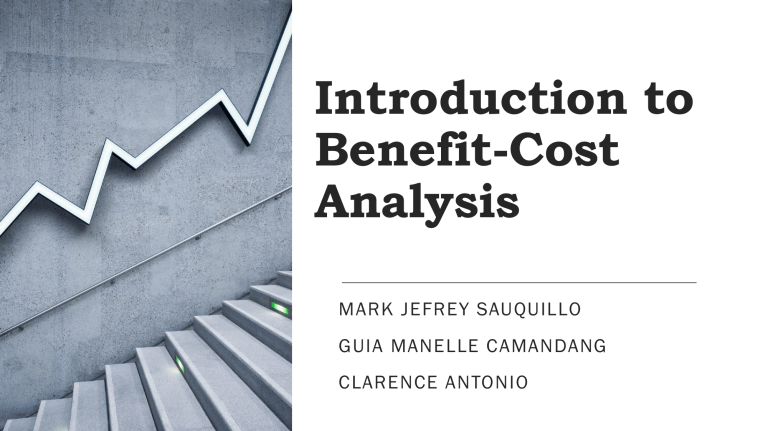
Introduction to Benefit-Cost Analysis MARK JEFREY SAUQUILLO GUIA MANELLE CAMANDANG CLARENCE ANTONIO “Information is a source of learning. But unless it is organized, processed, and available to the right people in a format for decision making, it is a burden, not a benefit.” — WILLIAM POLLARD What is Benefit-Cost Analysis is a systematic process that businesses use to analyze which decisions to make and which to forgo. The cost-benefit analyst sums the potential rewards expected from a situation or action and then subtracts the total costs associated with taking that action Application in My Field of Work Benefit-Cost Analysis (BCA) is a method that determines the future risk reduction benefits of a hazard mitigation project and compares those benefits to its costs. The result is a Benefit-Cost Ratio The Process of Benefit-cost Analysis Process of Cost-Benefit Analysis (1) (2) (3) (4) (5) (6) (7) (8) DEFINE THE PROBLEM ASSEMBLE EVIDENCE SELECT CRITERIA FOR MAKING THE DECISION IDENTIFY THE POLICY ALTERNATIVES TO BE CONSIDERED PREDICT THE OUTCOME OF EACH ALTERNATIVE CONFRONT THE TRADE-OFFS MAKE RECOMMENDATIONS TELL YOUR STORY Identifying the goals of the policy The goal of most public policies is to reduce, eliminate, or prevent a particular social or economic problem. Therefore, any convincing policy analysis should have clear and detailed answers to a seemingly simple set of questions: What is the problem? When, where, and how often does the problem occur? What are the causes of the problem? How serious are the harms caused by the problem? Assembling information and evidence Research now begins with a search of electronic sources such as online library catalogs and databases of academic or professional literature. It is also common to use unguided Web searches by typing keywords into a Web browser. Reliance on this unguided approach is not appropriate for serious research because of the existence of many unprofessional, ideologically biased, or fundraising websites associated with nearly any topic. Assembling information and evidence Identifying the seriousness of the problem involves quantifying both the number of people affected by the problem and the intensity of harm suffered by those people. Policy alternatives and decision criteria The most common rule for analyzing policy alternatives is the Kaldor-Hicks criterion or fundamental rule of policy analysis. This rule leads the analyst to rank projects according to their total net benefits, or total benefits minus total costs. Definition The Kaldor-Hicks principle states that a policy should be adopted if the winners could in principle compensate the losers, which requires that the total benefits outweigh the total costs. DECISION CRITERIA FOR BENEFIT COST ANALYSIS In this chapter, the benefit-cost analysis will be considered briefly using marginal analysis in order to display the connection between this analysis and the microeconomics on which it is based. More time will be spent reviewing benefit-cost decision rules that can be applied when imperfect information or other factors prevents the policy analyst from using marginal analysis. In practice, costbenefit studies are seldom based on explicit marginal costs and benefits, so these rules will be the most useful part of the chapter for most readers Marginal analysis of policy decisions is an examination of the associated costs and potential benefits of specific business activities or financial decisions. The goal is to determine if the costs associated with the change in activity will result in a benefit that is sufficient enough to offset them. For example, if a company has room in its budget for another employee and is considering hiring another person to work in a factory, a marginal analysis indicates that hiring that person provides a net marginal benefit. This means the ability to produce more products outweighs the increase in labor costs. Non-marginal decision criteria When information is not complete enough for marginal analysis, it is possible to compare the total or average benefits and costs of a policy using at least three different formulas. Net benefits = total benefits – total costs Benefit-cost ratio = total benefits/total costs Rate of return = 100% × (total benefits – total costs)/total costs
